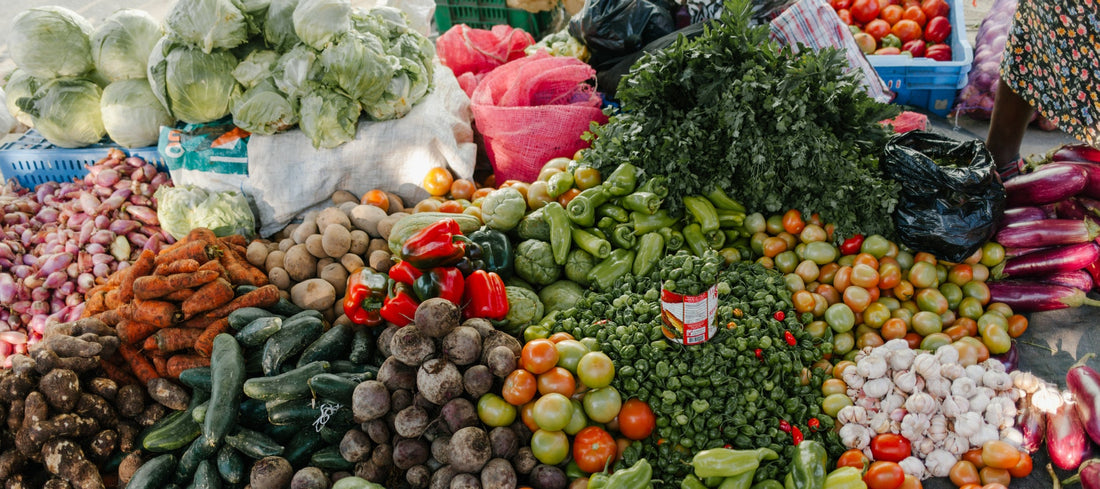Seasonal, Local Eating By Default
Long before humans were being told to “eat the rainbow”, humans ate locally and seasonally. Whoever coined the phrase must have been unaware of the fact that colorful aisles of produce don’t exist in nature.
For virtually all of history, as the seasons changed so did our diet. Over the course of a year, we may have consumed a colorful array of foods, but is there really any merit to intentionally eating the rainbow?
According to modern dietitians, yes. According to us, very little.
The fantasies of colorful plates dreamed up by modern dietitians have no bearing on the reality that we can thrive without eating a cornucopia of fruits and vegetables.

A different time of year has always meant a different offering of foods in our local environment. Plant foods are subject to seasonality while animal foods are more readily available year round.
If eating the rainbow was so miraculous, we’d have seen incredible improvements in our health the second we began shipping fruits and vegetables all over the world. Instead, we saw the opposite.
Despite what we’ve been told, eating the rainbow is not a panacea. It was never based on any nutrition science. It just sounded appealing.

Modern Grocery Stores Are Not Reality
Prior to the mid-nineteenth century, humans ate based on where they were located geographically and what was available seasonally. Nowadays, produce is shipped all across the world and it looks nothing like it did a few thousand years ago.
There’s a lot of hysteria around GMOs but what most people don’t realize is that almost all of our produce has been genetically modified for thousands of years. In other words, modern fruits and vegetables are artificial.
Take peaches for example. The modern peach is 64 times larger than a peach from 4,000 B.C. Back then, there were 3 known varieties of peaches and now there are over 200.
Modern corn is about 1,000 times larger than it was in 7,000 B.C. A quick google search of wild watermelons or wild bananas will also reveal the extent to which modern produce has been engineered.

So why does any of this matter? Well, even before the domestication of plants, we were thriving as hunter gatherers. And that’s not just a theory.
Whether we look at modern-hunter gatherer societies or the anthropological record of hunter-gatherers, there’s a common thread: the absence of degenerative diseases. These diseases are often called diseases of civilization and they’re directly linked to our diet.
So how do hunter-gatherers avoid degenerative diseases? Well, not by eating the rainbow.

In fact, 73% of worldwide hunter-gathers derive over 50% of their calories from animal foods (1). Again, that’s the diet that ensured we were free from chronic diseases.
The diet of these hunter-gatherers is the same diet that supported the development of the human body for 2.4 million years – 99.6% of the genus Homo’s time on earth. It mainly consists of hunted or fished animal foods along with a limited selection of foraged plant foods.
Some researchers believe that the diets of hunter-gatherers should serve as a model for developed nations plagued by chronic diseases (2). Certainly, this would be a more viable model than the grain-based food pyramid or the arbitrary recommendation to eat colorful foods.
Bright Colors: Beneficial or Bogus?
Previously, we’ve written about the drawbacks of plant foods and the myths surrounding fiber.
If modern dietitians were to recommend eating the most nutrient-dense foods, they would be forced to contradict themselves. After all, the pervading thought that animal foods are unhealthy clashes with the fact that they are loaded with healthy, bioavailable nutrients.
Espousing the benefits of fiber and antioxidants was one way to move us away from animal products. “Eat the rainbow” became another clever way to remind us to eat fruits and vegetables at the exclusion of animal foods.

In nature, the colors of plants often signal toxicity.
Polyphenols such as flavonoids give many fruits and vegetables a bright color. These are compounds that serve as a defense mechanism against predation. The mainstream calls them antioxidants, but they’re really antinutrients that interfere with the absorption of important micronutrients.
When they enter our body, they are poorly absorbed (3). And when they manage to cross the gut barrier, they are quickly destroyed in the liver just like other foreign molecules that the body doesn’t want in circulation (4).
Lectins and phytic acid are two other antinutrients that are protective for plants. Yet, in the human body, they can be problematic.
Phytic acid blocks the absorption of minerals like zinc and iron (5). And lectins can trigger local and systemic damage in the human body by binding to our intestinal lining (6).
The lectins in plants are so effective at warding off predators that plants have been genetically modified to contain higher concentrations of them (7).
Wine, berries, and dark chocolate were previously thought to be beneficial for their resveratrol content. Many people even thought this would explain the French paradox. Since then, the supposed benefits of resveratrol have been refuted (8).

While all of these may sound like appealing reasons to avoid plant foods all together or in high quantities, it really stresses the importance of preparing plant foods using traditional methods: soaking, sprouting, and fermenting. These processes detoxify plant foods and increase the bioavailability of their nutrients.
In the past, antinutrients may have been very tolerable considering that they weren’t available year round. Clearly, we could not blend up kale and spinach into a smoothie every morning. Daily green smoothies may even be a recipe for the accumulation of oxalates in our body (9).
Okay, so there’s antinutrients in plant foods, but why does this even matter?
We Need a Break
Given that our ancestors were eating some antinutrients, it would not have been at every meal, let alone every day. Humans can tolerate these compounds in moderate amounts, every so often. Yet, for some strange reason, we are being told to load up on them 3 times a day.
To some extent, varying the colors in our diet may promote gut health or hormesis. Except, the notion of hormesis only applies to small doses of stressors. We should aim to be robust and tolerable of different foods, and that’s precisely what we get by eating with the seasons.

Our food choices were likely more diverse and colorful in warmer months while the winter was more monotonous. And that’s what our body is accustomed to. We transitioned from eating the rainbow over the course of an entire year to eating the rainbow multiple times a day, in some cases.
We are living in the same body as our hunter-gatherer ancestors and expecting it to adapt to an influx of antinutrients. It’s no wonder we’re seeing an explosion in gut-related health conditions whether it’s digestive issues, autoimmunity or neurological disorders.
Interestingly, people who take a step back from the mainstream dogma and adopt a Sapien approach often see astonishing improvements in their health. These improvements stem from changing what we are putting in our gut.
Reality Check
In many ways, the entire field of mainstream nutrition science is lacking common sense. Their slogan might as well be: if it’s not broken, let’s fix it. In some sense, the human diet was perfected millennia ago. And instead of trying to piece it back together, we’ve resorted to “eat the rainbow” nonsense.
It’s easy to mistake myopic studies for blanket nutritional truths. Scientists find a promising polyphenol, like curcumin which is found in turmeric, and suddenly it’s a cure-all.

People will dump turmeric on their food or take a supplement for a few months before seeing no real improvements. This is definitely a profitable scheme but eventually the spotlight moves on.
At the end of the craze, a review found that none of the serious trials were successful in proving curcumins’ benefits (10). Hundreds of millions of dollars, including federal funds, were wasted in over 120 clinical trials only for curcumin to be labeled non-bioavailable, inactive and an improbable lead.
That’s just one of many examples. The truth is that we cannot afford to extrapolate data from random studies, most of which are observational, without taking into account the millions of years that contradict their findings.
We also can’t assume that what works for some people, will work for everyone.
The idea that small amounts are good is almost always interpreted as more is better. And unfortunately, that’s what has been happening in the health sphere for decades.
Seasonal eating is nuanced but it cannot be ignored. It’s really one of the foundations of our diet.

Fun for Flavor & Variety
Big plates of colorful and flavorful foods can be fun. There’s nothing wrong with it if you enjoy it. Just remember that we should walk away from every meal feeling great and satiated!
Some of the most delicious plates include a variety of animal-based foods with some fermented vegetables, seasonings, or other plant dishes on the side, and perhaps fruit for dessert. This isn’t a hodgepodge of foods. It’s what we’ve seen first hand in some of the healthiest traditional cultures on earth.
Just ask yourself, what plant foods are in season? The bulk of our nutrition can come from animal-sourced foods and from there we can look to incorporate some delicious plants, preferably ones that are in season.
By doing this we reap the benefits of plant foods without testing our biological limits. As far as we’re concerned, eating the rainbow every day or at every meal is a plant-based fairy tale. It’s certainly not the fountain of youth.
Lastly, let’s not forget the importance of the color red in this rainbow. And we’re not talking about watermelons or red peppers.

We’re talking about one of the best sources of protein and micronutrients on the planet: red meat.
If eating the rainbow includes eating a variety of meats, with the bulk of our calories coming from animal-sourced foods, then sure, eat the rainbow.
Otherwise, we can thrive by unintentionally eating the rainbow over the course of a year.
- https://academic.oup.com/ajcn/article/71/3/682/4729121
- https://pubmed.ncbi.nlm.nih.gov/11157335/
- http://www.ncbi.nlm.nih.gov/pubmed/17157175
- http://www.ncbi.nlm.nih.gov/pubmed/17157175
- https://academic.oup.com/ajcn/article/78/3/633S/4690005
- https://pubmed.ncbi.nlm.nih.gov/15302522/
- https://www.ncbi.nlm.nih.gov/pmc/articles/PMC1115659/
- https://jamanetwork.com/journals/jamainternalmedicine/fullarticle/1868537
- https://pubmed.ncbi.nlm.nih.gov/8335871/
- https://pubs.acs.org/doi/10.1021/acs.jmedchem.6b00975
EAT WELL. LIVE WELL.
Brian Sanders, founder of NoseToTail.org and Sapien.org
Dan Patterson, Head Writer at Sapien.org

